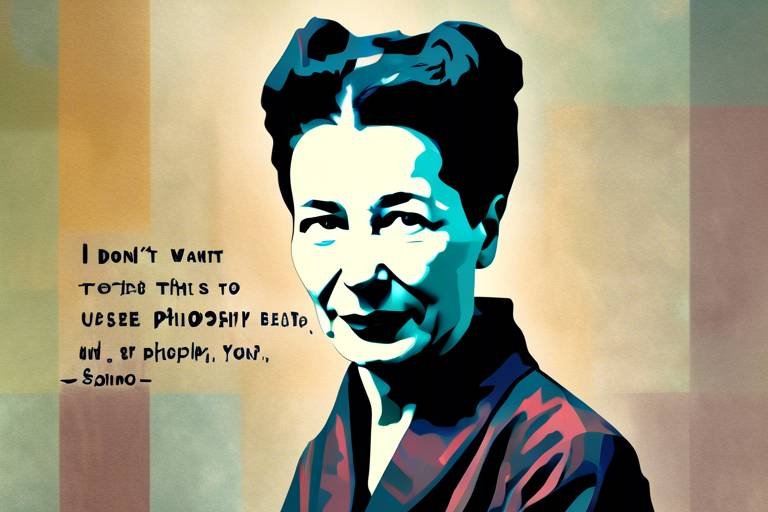Stoicism and Emotions: How Seneca Offers a Guide?
In a world that often feels like a whirlwind of chaos, understanding how to manage our emotions can seem like an uphill battle. Enter Stoicism, a philosophy that offers timeless wisdom on emotional resilience and personal growth. Among its most prominent figures is Seneca, a Roman philosopher whose teachings illuminate the path to emotional mastery. This article delves into Seneca's insights, providing practical strategies to help you navigate the turbulent waters of life with grace and poise.
Stoicism originated in ancient Greece and was later popularized in Rome, becoming a guiding philosophy for many. At its core, Stoicism teaches the importance of virtue, reason, and self-control. In today's fast-paced world, where emotions can often dictate our actions, Stoicism serves as a beacon, offering tools to help us remain grounded. It encourages us to focus on what we can control while letting go of what we cannot, which is particularly relevant when grappling with our feelings.
Seneca, born in 4 BC, lived a life filled with political intrigue, personal tragedy, and philosophical exploration. His experiences shaped his views on emotions and ethics. He believed that emotions, while natural, could lead us astray if not properly understood. Through his writings, Seneca urges us to reflect on our emotional responses, emphasizing the need for a virtuous life that aligns with reason rather than impulse.
In Stoicism, emotions are seen as a double-edged sword. On one hand, they can enrich our lives; on the other, they can lead to irrational decisions. Seneca differentiates between rational emotions, which are aligned with virtue, and irrational feelings that can cloud our judgment. By understanding this distinction, we can better navigate our emotional landscape and make decisions that reflect our true selves.
Stoicism encourages us to cultivate positive emotions like joy and gratitude while managing negative ones such as anger and fear. This doesn't mean suppressing our feelings but rather acknowledging them and choosing how to respond. By practicing mindfulness and reflection, we can transform destructive emotions into opportunities for growth.
One of the most profound gifts of Stoicism is the development of emotional resilience. Life is filled with challenges, but by adopting a Stoic mindset, we can face adversity with a calm and rational approach. This resilience not only helps us endure difficult times but also fosters personal growth, allowing us to emerge stronger and more self-aware.
Seneca offers various practical techniques for managing emotions. One effective method is journaling, where you can reflect on your feelings and thoughts. Another powerful exercise is negative visualization, which involves imagining the loss of things you cherish. This practice helps you appreciate what you have and prepares you mentally for life's inevitable challenges. By integrating these techniques into your daily routine, you can cultivate a deeper understanding of your emotions.
Incorporating Stoic practices into your everyday life can lead to a more balanced emotional state. Start by setting aside a few moments each day for reflection. Consider what you can control and what is beyond your grasp. This simple practice can significantly reduce anxiety and enhance your overall well-being.
Mindfulness and Stoicism go hand in hand. Being present and aware of your thoughts and feelings is crucial for emotional clarity. When you practice mindfulness, you can observe your emotions without judgment, allowing you to respond rather than react. This awareness empowers you to make choices aligned with your values, fostering a sense of peace amidst life's chaos.
Adopting Stoic practices can yield long-term benefits for your emotional well-being. Many individuals report improved mental health, stronger relationships, and a greater sense of purpose. By embracing Stoicism, you can cultivate a fulfilling life that is not dictated by fleeting emotions but rather grounded in enduring principles.
- What is Stoicism? Stoicism is an ancient philosophy that teaches the development of self-control and fortitude as a means to overcome destructive emotions.
- Who was Seneca? Seneca was a Roman philosopher, statesman, and playwright whose writings on Stoicism have influenced countless individuals seeking emotional resilience.
- How can I apply Stoicism in my life? You can apply Stoicism by practicing mindfulness, journaling your thoughts, and focusing on what you can control while letting go of what you cannot.
- What are the benefits of practicing Stoicism? The benefits include improved emotional regulation, enhanced mental health, stronger relationships, and a more profound sense of purpose.

Understanding Stoicism
Stoicism is a profound philosophy that originated in ancient Greece, founded by Zeno of Citium around 300 BCE. It teaches us how to live a life of virtue and wisdom, emphasizing the importance of reason and self-control. In a world that often feels chaotic and overwhelming, Stoicism offers a beacon of clarity, guiding us through the tumultuous waters of our emotions. But what exactly does it mean to be a Stoic? At its core, Stoicism is about recognizing what we can control and what we cannot. This principle is not just a philosophical abstraction; it’s a practical tool for navigating daily challenges.
One of the key tenets of Stoicism is the distinction between our thoughts and external events. Stoics argue that while we cannot control external circumstances, we can control our reactions to them. This perspective is incredibly relevant today, as many of us find ourselves overwhelmed by stress, anxiety, and the pressures of modern life. By embracing Stoic principles, we can cultivate a mindset that fosters emotional resilience and stability.
Moreover, Stoicism encourages us to practice mindfulness and reflection. It invites us to pause and examine our thoughts, allowing us to identify irrational beliefs that may be fueling negative emotions. For instance, when faced with a setback, instead of succumbing to despair, a Stoic would ask themselves, “What can I learn from this?” This shift in perspective transforms obstacles into opportunities for growth.
In today's fast-paced world, where instant gratification often overshadows long-term fulfillment, Stoicism serves as a reminder that true happiness comes from within. It teaches us to focus on our character and actions rather than external validation. By aligning our lives with Stoic values, we can achieve a sense of inner peace and purpose.
To further understand the relevance of Stoicism in our lives, consider the following core principles:
- Virtue is the highest good: Stoics believe that living a virtuous life—characterized by wisdom, courage, justice, and temperance—is essential for true happiness.
- Focus on what you can control: This principle emphasizes the importance of distinguishing between what is within our control (our thoughts and actions) and what is not (other people's opinions, external events).
- Practice gratitude: By appreciating what we have rather than lamenting what we lack, we cultivate a positive mindset.
- Accept the impermanence of life: Stoics remind us that change is inevitable, and accepting this can help us navigate life's ups and downs with grace.
In summary, Stoicism is not just an ancient philosophy; it is a practical guide that remains relevant in today's world. By understanding and applying its principles, we can learn to manage our emotions more effectively, leading to a more balanced and fulfilling life.

Seneca's Life and Philosophy
Lucius Annaeus Seneca, commonly known as Seneca, was a Roman Stoic philosopher, statesman, and playwright born around 4 BCE in Corduba, Hispania. His life was a tapestry of contrasts; he was a man of great intellect and moral fortitude, yet he navigated the turbulent waters of Roman politics and personal tragedy. Seneca's teachings on Stoicism were not merely theoretical; they were deeply rooted in his own experiences of hardship, exile, and the complexities of human emotion.
Seneca's philosophy is often encapsulated in his belief that virtue is the highest good. He argued that true happiness comes from living in accordance with nature and reason, rather than being swept away by the chaos of external circumstances. For Seneca, emotions were not to be suppressed but understood and managed. He viewed emotions as natural responses that, when unchecked, could lead to irrational behavior. This perspective is critical in understanding how he approached the emotional challenges of his life.
Throughout his life, Seneca faced numerous challenges, including political intrigue that led to his forced suicide in 65 CE. Despite these adversities, he remained committed to the Stoic ideals of resilience and self-control. His letters, particularly the famous “Letters to Lucilius,” provide profound insights into his philosophy and practical advice on how to deal with life's inevitable struggles. In these letters, Seneca emphasizes the importance of self-reflection and the cultivation of inner peace.
In his writings, Seneca often distinguished between two kinds of emotions: rational and irrational. Rational emotions, such as joy and love, align with virtue and contribute positively to our lives. On the other hand, irrational emotions, like anger and envy, can cloud our judgment and lead us astray. This distinction is crucial for anyone seeking to understand the Stoic approach to emotional management. By recognizing the nature of our feelings, we can learn to respond to them in a more constructive manner.
Seneca's teachings also highlight the importance of practical application. He believed that philosophy should not be confined to academic discourse but should be a guide for everyday living. This practical approach is evident in his emphasis on techniques such as journaling and reflection, which help individuals to process their emotions and align their actions with their values.
In summary, Seneca's life and philosophy serve as a beacon for those navigating the emotional landscape of modern life. His insights remind us that while we cannot control external events, we can control our responses to them. By embracing the Stoic principles that Seneca championed, we can cultivate emotional resilience and lead a life of purpose and fulfillment.

The Nature of Emotions in Stoicism
In the realm of Stoicism, emotions are not merely fleeting feelings; they are complex responses that can significantly influence our actions and decisions. Stoics, particularly thinkers like Seneca, believed that understanding the nature of our emotions is crucial for achieving a balanced and fulfilling life. At the core of Stoic philosophy lies the distinction between rational and irrational emotions. Rational emotions align with reason and virtue, guiding us toward wise choices, while irrational emotions stem from misguided perceptions and can lead us astray.
To grasp the essence of Stoic thought, it's essential to recognize how emotions play a role in human behavior. Stoicism teaches us that while we cannot control external events, we can control our reactions to them. This perspective empowers individuals to cultivate emotional intelligence and resilience. For instance, when faced with adversity, a Stoic would encourage a response rooted in reason rather than succumbing to panic or despair. This approach not only fosters inner peace but also enhances our ability to navigate life's challenges effectively.
Furthermore, Stoicism emphasizes the importance of self-awareness in managing emotions. By examining our feelings and understanding their origins, we can differentiate between those that serve us well and those that hinder our progress. This practice of introspection is akin to holding up a mirror to our emotional state, allowing us to reflect on how our feelings align with our values and goals. As Seneca famously stated, “We suffer more often in imagination than in reality.” This quote encapsulates the Stoic view that many of our emotional struggles stem from our perceptions rather than the actual events themselves.
To illustrate the Stoic perspective on emotions, consider the following table that contrasts rational and irrational emotions:
| Type of Emotion | Description | Impact on Behavior |
|---|---|---|
| Rational Emotions | Emotions aligned with reason and virtue, promoting well-being. | Encourages wise decision-making and resilience. |
| Irrational Emotions | Emotions based on misconceptions or misinterpretations. | Can lead to impulsive actions and emotional turmoil. |
In summary, the Stoic understanding of emotions invites us to engage in a deeper examination of our feelings. By recognizing the difference between rational and irrational emotions, we can cultivate a mindset that prioritizes clarity and reason. This not only aids in personal development but also enhances our interactions with others. Ultimately, embracing the Stoic approach to emotions equips us with the tools to lead a more meaningful and resilient life.

Positive vs. Negative Emotions
When we talk about emotions, it's almost like discussing the weather; they can change in an instant and influence our day-to-day lives significantly. In the realm of Stoicism, emotions are viewed through a unique lens. The Stoics, particularly Seneca, emphasized the importance of distinguishing between positive and negative emotions. This distinction isn't just a philosophical exercise; it's a practical guide to navigating life's turbulent waters.
Positive emotions, such as joy, love, and gratitude, can be likened to a gentle breeze that lifts our spirits and allows us to soar. These feelings encourage connection, foster resilience, and promote a sense of well-being. Stoicism doesn't advocate suppressing these emotions; rather, it encourages us to cultivate and appreciate them. Recognizing and nurturing positive feelings can lead to a more fulfilling life, one where we find joy in even the smallest moments.
On the flip side, we have negative emotions—fear, anger, jealousy, and sadness. These can feel like storm clouds looming overhead, threatening to dampen our spirits. Stoicism teaches us that while these emotions are natural, they can also be destructive if left unchecked. Seneca believed that understanding the root causes of our negative emotions is crucial. By examining why we feel a certain way, we can begin to detach from these feelings, preventing them from dictating our actions.
To navigate the spectrum of emotions effectively, Seneca proposed several techniques. One of these is the practice of mindful awareness. This involves acknowledging our emotions without judgment, allowing us to understand their origins and impacts. By doing so, we can transform negative emotions into opportunities for growth. For instance, instead of succumbing to anger, we can ask ourselves, "What triggered this reaction?" This kind of reflective practice can lead to profound insights and emotional clarity.
Moreover, Seneca advocated for the idea of emotional moderation. This doesn't mean we should avoid negative emotions entirely; rather, we should aim to experience them in a balanced way. By understanding that emotions are transient, we can cultivate a perspective that allows us to ride the waves of our feelings without getting overwhelmed. This balance can be achieved through practices such as journaling, where we can express and process our emotions on paper, helping to clarify our thoughts and feelings.
In summary, the Stoic approach to emotions is all about awareness and balance. By recognizing the difference between positive and negative emotions, we can learn to embrace the former while managing the latter. This understanding not only enhances our emotional resilience but also paves the way for personal growth. Just as a gardener tends to their plants, nurturing the positive while pruning away the negative, we too can cultivate a healthier emotional landscape.
- What are the key differences between positive and negative emotions in Stoicism?
Positive emotions are seen as beneficial and should be cultivated, while negative emotions are acknowledged but managed to prevent them from controlling our actions. - How can I cultivate positive emotions?
Practices such as gratitude journaling, mindfulness, and engaging in activities that bring joy can help nurture positive feelings. - What techniques can help manage negative emotions?
Reflective practices, such as journaling and mindful awareness, can assist in understanding and mitigating negative emotions. - Is it okay to feel negative emotions?
Absolutely! Stoicism acknowledges that negative emotions are a part of the human experience. The goal is to manage them constructively.

Emotional Resilience through Stoicism
Emotional resilience is like a sturdy ship navigating through the stormy seas of life. It’s not about avoiding the waves but learning to ride them with grace and strength. Stoicism, an ancient Greek philosophy, offers profound insights into building this resilience. By embracing its teachings, we can develop a mindset that not only withstands emotional turbulence but also thrives in its wake.
At its core, Stoicism teaches us that while we cannot control external events, we can control our reactions to them. This fundamental principle is crucial for emotional resilience. Imagine facing a setback, like losing a job. A Stoic approach encourages you to view this not as a catastrophe but as an opportunity for growth. Instead of succumbing to despair, you might ask yourself, “What can I learn from this experience?” This shift in perception allows you to harness your emotions constructively rather than letting them overwhelm you.
Moreover, the Stoics emphasize the practice of negative visualization, which involves contemplating potential challenges and losses. While it may sound counterintuitive, this technique prepares your mind for adversity. By imagining worst-case scenarios, you reduce the shock when they occur, making it easier to cope. For instance, if you think about the possibility of losing a loved one, you may cherish your time with them even more, fostering deeper connections and appreciation.
Another vital aspect of Stoicism is the distinction between rational and irrational emotions. Stoics advocate for the examination of our feelings, allowing us to separate what is within our control from what is not. This practice can be likened to a filter, helping us to sift through the chaos of our emotions and focus on what truly matters. By doing so, we cultivate a sense of calm and clarity, which is essential for resilience. It’s about transforming emotional turmoil into a source of strength.
Incorporating these Stoic principles into daily life can significantly enhance emotional resilience. For example, maintaining a journal can be a powerful tool. Through writing, you can reflect on your feelings, analyze your reactions, and identify patterns in your emotional responses. This practice not only promotes self-awareness but also empowers you to make conscious choices about how to respond to life's challenges.
Ultimately, emotional resilience through Stoicism is about creating a robust mental framework that can withstand life's inevitable ups and downs. It’s about embracing the idea that while we cannot control everything that happens to us, we have the power to shape our responses. By cultivating this mindset, we become not just survivors of our circumstances but active participants in our emotional journey, equipped to meet any storm with courage and grace.

Practical Techniques from Seneca
Seneca, one of the most prominent figures in Stoic philosophy, offers a treasure trove of practical techniques that can help individuals manage their emotions effectively. His teachings encourage us to engage in self-reflection and cultivate a mindset that embraces rational thinking over emotional turmoil. One of the most powerful methods he advocates is journaling. By writing down our thoughts and feelings, we can gain clarity about our emotional state. This practice not only allows for a better understanding of our reactions but also provides a safe space to explore our innermost feelings without judgment.
Another technique that Seneca emphasizes is the practice of negative visualization. This might sound counterintuitive at first, but it involves envisioning the worst-case scenarios in our lives. By contemplating what we fear losing or what challenges we might face, we prepare ourselves mentally for adversity. This technique helps to diminish the impact of negative emotions when they arise because we have already considered them. Imagine walking into a storm with an umbrella; you’re prepared for the rain, and it doesn’t catch you off guard!
Seneca also encourages daily reflection. He suggests taking time at the end of each day to evaluate our actions and emotional responses. This practice can be as simple as asking ourselves a few questions: Did I react to situations with wisdom? What emotions did I feel today, and were they justified? This reflective practice is akin to holding a mirror to our souls, allowing us to recognize patterns in our behavior and adjust accordingly. Over time, this can lead to significant emotional growth.
Moreover, engaging in philosophical discussions can be incredibly beneficial. Seneca believed that sharing ideas and thoughts with others helps to solidify our understanding of Stoic principles. It’s like a workout for the mind; the more we discuss and challenge our beliefs, the stronger our emotional resilience becomes. Whether it’s through formal study groups or casual conversations with friends, these discussions can illuminate our understanding of emotions and how to manage them.
Lastly, Seneca’s emphasis on virtue as the highest good is a guiding principle in managing emotions. By striving to live a virtuous life, we align our actions with our values, which can lead to a more stable emotional state. When we act with integrity and purpose, we become less susceptible to the emotional turbulence that often accompanies life’s challenges. It's like sailing a ship; when you have a clear direction, the storms become easier to navigate.
In summary, Seneca's practical techniques—journaling, negative visualization, daily reflection, engaging in philosophical discussions, and striving for virtue—offer a robust framework for managing emotions. By incorporating these practices into our daily lives, we can cultivate a sense of emotional resilience that not only helps us face life's challenges but also promotes personal growth and fulfillment.
- What is the main focus of Seneca's teachings? Seneca's teachings primarily focus on the importance of rational thinking and the management of emotions through Stoic principles.
- How can journaling help with emotional management? Journaling allows individuals to clarify their thoughts and feelings, leading to better emotional understanding and regulation.
- What is negative visualization and why is it useful? Negative visualization is the practice of contemplating worst-case scenarios to mentally prepare for adversity, which helps reduce the emotional impact when faced with challenges.
- How does daily reflection contribute to emotional resilience? Daily reflection helps individuals assess their reactions and behaviors, promoting self-awareness and emotional growth over time.
- Why is virtue important in Stoicism? Virtue is considered the highest good in Stoicism, and living in accordance with one’s values leads to a more stable emotional state and greater fulfillment.

Applying Stoicism in Daily Life
In a world that often feels chaotic and overwhelming, applying Stoicism in our daily lives can serve as a beacon of clarity. Imagine waking up each morning with a sense of purpose, equipped with the tools to handle whatever life throws your way. Stoicism isn’t just a philosophy for philosophers; it’s a practical guide for anyone looking to cultivate emotional resilience and a balanced mindset. So, how can we weave Stoic principles into the fabric of our everyday routines?
First and foremost, it’s about mindset. Stoicism teaches us to focus on what we can control and to let go of what we can’t. This simple yet profound shift in perspective can dramatically alter how we approach our day. For instance, when faced with a stressful situation, instead of succumbing to anxiety, we can ask ourselves, “What can I control in this moment?” This question serves as a powerful reminder that while we may not be able to change external circumstances, we can control our reactions and thoughts.
Another practical application of Stoicism is through the practice of daily reflection. Taking a few moments each day to reflect on our actions and emotions can be incredibly enlightening. This could be as simple as journaling about the day’s events, noting what went well and what didn’t. By doing so, we not only gain insight into our emotional responses but also identify patterns that may need addressing. For instance, if we notice that certain situations consistently trigger negative emotions, we can prepare ourselves better for those moments in the future.
Moreover, embracing the concept of negative visualization can be a game-changer. This technique involves imagining the worst-case scenarios, not to dwell on negativity, but to appreciate what we have and prepare ourselves mentally for potential challenges. By visualizing loss or adversity, we can cultivate gratitude and resilience. It’s like training for a marathon; while the race may be tough, we become stronger and more capable through preparation.
Incorporating Stoicism into our daily lives also means practicing mindfulness. Being present and aware of our thoughts and feelings allows us to respond rather than react. When we feel anger bubbling up, for example, mindfulness gives us the space to pause and choose a more constructive response. This can prevent us from saying something we might regret later. It’s akin to hitting the brakes before a collision; a moment of mindfulness can save us from emotional wreckage.
To help you visualize how to seamlessly integrate these practices, here’s a simple table illustrating Stoic practices and their applications:
| Stoic Practice | Application |
|---|---|
| Mindset Shift | Focus on what you can control |
| Daily Reflection | Journaling about your day |
| Negative Visualization | Prepare for challenges by imagining worst-case scenarios |
| Mindfulness | Pause and reflect before reacting |
Lastly, remember that applying Stoicism is not about suppressing emotions or becoming cold-hearted. Instead, it’s about understanding and managing our emotions effectively. Just like a seasoned sailor learns to navigate through storms, we too can learn to sail through life’s turbulent waters with grace and strength. By integrating these Stoic practices into our daily routines, we not only enhance our emotional resilience but also pave the way for a more fulfilling life.
- What is Stoicism? Stoicism is an ancient Greek philosophy that teaches the development of self-control and fortitude as a means to overcome destructive emotions.
- How can I start practicing Stoicism? Begin by focusing on what you can control, reflecting on your thoughts and actions, and practicing mindfulness daily.
- Is Stoicism about suppressing emotions? No, Stoicism encourages understanding and managing emotions rather than suppressing them.
- Can Stoicism help with anxiety? Yes, by shifting your mindset and focusing on what you can control, Stoicism can provide tools to manage anxiety effectively.

Mindfulness and Stoicism
When we think about mindfulness and Stoicism, it might seem like we're talking about two different worlds. However, they actually complement each other beautifully, creating a powerful toolkit for emotional clarity and resilience. Mindfulness is all about being present in the moment, fully aware of our thoughts and feelings without judgment. On the other hand, Stoicism teaches us how to respond to those thoughts and feelings in a rational way. Imagine standing on the edge of a cliff, feeling the wind rush past you. Mindfulness allows you to experience that wind, to feel it on your skin, while Stoicism provides the wisdom to understand that the cliff is just a cliff, and you have the power to choose how to respond to your surroundings.
At its core, the combination of mindfulness and Stoicism encourages us to observe our emotions without letting them control us. This is particularly important in today's fast-paced world, where distractions and stressors are everywhere. By practicing mindfulness, we develop the ability to pause and reflect before reacting, which is a key tenet of Stoic philosophy. Think of it as hitting the brakes before speeding into an intersection; it gives you time to assess the situation and make a more informed decision.
One practical way to integrate mindfulness with Stoicism is through daily reflection. This can be as simple as taking a few minutes each day to sit in silence and observe your thoughts. Ask yourself questions like, “What emotions am I feeling right now?” or “How can I respond to these feelings in a way that aligns with my values?” This act of reflection not only enhances your mindfulness but also aligns with the Stoic practice of self-examination, which Seneca himself advocated.
Moreover, mindfulness can help us identify irrational emotions that may lead us astray. For instance, feelings of anger or jealousy can cloud our judgment. By being mindful, we can recognize these emotions as they arise, allowing us to question their validity and decide whether to act on them. This practice echoes the Stoic principle of distinguishing between what we can control and what we cannot. By acknowledging our emotions but not letting them dictate our actions, we cultivate a more peaceful and balanced state of being.
To illustrate the synergy between mindfulness and Stoicism, consider the following table that outlines key aspects of both practices:
| Aspect | Mindfulness | Stoicism |
|---|---|---|
| Focus | Present moment awareness | Rational response to events |
| Goal | Emotional clarity | Virtuous living |
| Practice | Meditation, reflection | Self-examination, journaling |
| Emotional Management | Observation without judgment | Choosing rational responses |
Incorporating mindfulness into your Stoic practice can lead to profound changes in how you approach life's challenges. It allows you to cultivate a deeper understanding of yourself and your emotions, ultimately leading to a more fulfilling and balanced life. So, the next time you find yourself overwhelmed by feelings, remember to take a step back, breathe, and embrace the moment. You have the tools within you to navigate your emotions with grace and wisdom.

Long-term Benefits of Stoic Practices
When you think about Stoicism, you might picture a bunch of ancient philosophers sitting around in togas, but the truth is that the teachings of Stoicism, particularly those of Seneca, have profound, lasting benefits for our modern lives. Imagine waking up each day with a sense of purpose and emotional clarity—sounds pretty appealing, right? By integrating Stoic practices into your daily routine, you can cultivate a mindset that not only helps you tackle life's challenges but also enhances your overall well-being.
One of the most significant long-term benefits of Stoic practices is improved mental health. In a world where anxiety and stress seem to be the norm, Stoicism offers a refreshing perspective. By focusing on what we can control and accepting what we cannot, we reduce the mental clutter that often leads to feelings of overwhelm. This shift in mindset can lead to a decrease in anxiety and depression, allowing us to navigate life's ups and downs with greater ease.
Moreover, practicing Stoicism fosters stronger relationships. When you adopt a Stoic approach, you learn to respond to others with empathy and understanding rather than reacting impulsively. This emotional regulation not only enhances your interactions but also builds a foundation of trust and respect with those around you. Relationships thrive on communication, and with Stoicism, you become more attuned to your own emotions, which allows you to connect with others on a deeper level.
Another remarkable benefit is the development of a greater sense of purpose and fulfillment. Stoicism teaches us to reflect on our values and what truly matters in life. By engaging in regular self-reflection and aligning our actions with our core beliefs, we can lead more meaningful lives. This sense of purpose acts as a guiding star, helping us stay focused and motivated, even when the going gets tough.
To give you a clearer picture, let's take a look at some of the long-term benefits of Stoic practices in a table format:
| Benefit | Description |
|---|---|
| Mental Health Improvement | Reduces anxiety and depression by focusing on what can be controlled. |
| Stronger Relationships | Enhances emotional regulation and fosters empathy in interactions. |
| Greater Purpose | Encourages alignment of actions with core values for a fulfilling life. |
| Emotional Resilience | Builds the ability to face adversity with calmness and rationality. |
Lastly, let’s not forget about the emotional resilience that Stoic practices cultivate. Life is unpredictable, and challenges are inevitable. However, with the tools provided by Stoicism, you can develop a robust framework for facing these challenges head-on. You’ll find that instead of crumbling under pressure, you can maintain a sense of composure and clarity, allowing you to make better decisions in tough situations.
In summary, the long-term benefits of Stoic practices are not just theoretical; they manifest in tangible improvements in mental health, relationships, and overall life satisfaction. By embracing these teachings, you arm yourself with a powerful toolkit for navigating the complexities of modern life. So, why not start today? The journey of a thousand miles begins with a single step, and in this case, that step could lead you to a more resilient and fulfilling life.
- What is Stoicism? Stoicism is an ancient philosophy that teaches the development of self-control and fortitude as a means to overcome destructive emotions.
- How can I start practicing Stoicism? You can start by reading Stoic texts, reflecting on your values, and practicing mindfulness to become more aware of your emotions.
- Are there any modern applications of Stoicism? Yes! Many people use Stoic principles in personal development, leadership, and stress management.
Frequently Asked Questions
- What is Stoicism?
Stoicism is an ancient Greek philosophy that teaches the development of self-control and fortitude as a means to overcome destructive emotions. It emphasizes rationality and the importance of virtue, helping individuals navigate life's challenges with a calm and resilient mindset.
- Who was Seneca and what role did he play in Stoicism?
Seneca was a Roman philosopher, statesman, and playwright who significantly contributed to Stoic philosophy. His writings provide practical guidance on how to apply Stoic principles to everyday life, particularly in managing emotions and achieving personal growth.
- How does Stoicism define emotions?
In Stoicism, emotions are seen as responses to external events that can be either rational or irrational. Rational emotions align with virtue and reason, while irrational emotions can lead to destructive behavior. Understanding this distinction is key to managing one's emotional responses effectively.
- Can Stoicism help with negative emotions?
Absolutely! Stoicism offers tools and techniques to manage negative emotions. By practicing mindfulness, reflection, and negative visualization, individuals can cultivate emotional resilience and learn to respond to challenges with a balanced perspective.
- What practical techniques does Seneca recommend for emotional management?
Seneca suggests various techniques such as journaling, daily reflection, and the practice of negative visualization. These methods help individuals prepare for potential challenges and develop a deeper understanding of their emotions.
- How can I apply Stoicism in my daily life?
Incorporating Stoicism into your daily routine can be simple. Start by practicing mindfulness, reflecting on your thoughts and feelings, and applying Stoic principles when faced with challenges. This will help you develop a more resilient approach to life's ups and downs.
- What are the long-term benefits of practicing Stoicism?
Long-term practice of Stoicism can lead to numerous benefits, including improved mental health, stronger relationships, and a greater sense of purpose. By fostering emotional resilience and a balanced mindset, individuals can navigate life's complexities with greater ease.



















